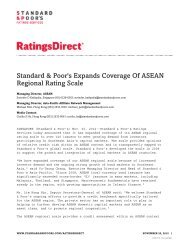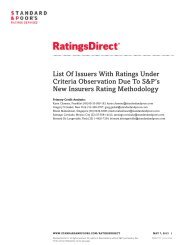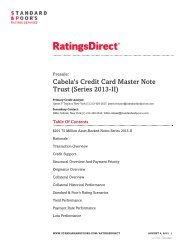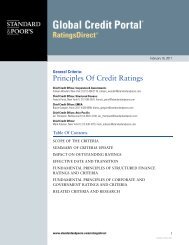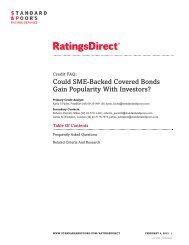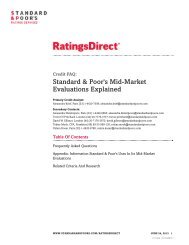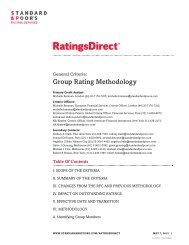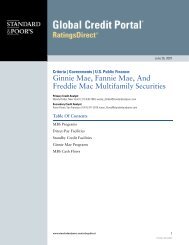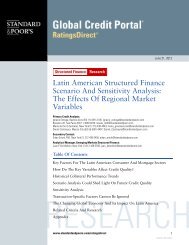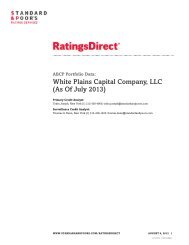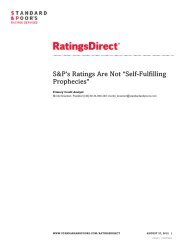What May Cause Insurance Companies To Fail ... - Standard & Poor's
What May Cause Insurance Companies To Fail ... - Standard & Poor's
What May Cause Insurance Companies To Fail ... - Standard & Poor's
Create successful ePaper yourself
Turn your PDF publications into a flip-book with our unique Google optimized e-Paper software.
<strong>What</strong> <strong>May</strong> <strong>Cause</strong> <strong>Insurance</strong> <strong>Companies</strong> <strong>To</strong> <strong>Fail</strong>--And How This Influences Our Criteriapredominantly real estate developments, including several intercompany loans. Real-estate equity investments alsodamaged the value and liquidity of Monarch Life's assets, and, in 1992, the insurer had to stop writing new life andannuity business. Around the same time, Kentucky Central and Confederation bore the brunt of large exposures tomortgage loans on commercial real estate, including construction loans on new developments and high loan-to-valuemortgages, which performed poorly following the 1991-1992 U.S. recession.Our capital model, introduced in 1994, has been refined over time to reflect experience of default rates on certaintypes of bonds and portfolio losses. One change, for example, was the increased loss experience data for commercialmortgages. The model applies substantial risk charges for speculative-grade bonds and for nonperforming real estateloans. Following the market downturn in 2007-2008, we introduced refined security-specific recovery analytics forcertain parts of insurance investment portfolios, such as structured finance assets.In 2012, we updated our capital model charges for commercial loan holdings of life insurers, adding greaterdifferentiation by loan quality characteristics and applying a commensurate risk charge to construction loans. Thischange aims at identifying and taking into account risk in the loan portfolios before losses emerge.The risk position factor within our new criteria framework takes account of the following heightened investment risks:• Outsized asset concentrations by single obligor or asset class; and• Outsized exposure to high risk assets.In this way, we seek to reflect the potential for increased volatility beyond what is modeled for under our capitalcriteria.…And Reinforced By The Liability StructureThese liquidity-related failures also highlighted to us the different ways in which certain types of policyholders react intimes of stress. Withdrawal rates spike for certain types of products, and we reflected this in the adjustments that wemade to our liquidity criteria (see below). In the case of the U.S. failures, the primary liquidity strains came fromaccelerated institutional Guaranteed Investment Contract (GIC) surrenders, while surrenders of fixed annuities andinterest-sensitive life insurance provided secondary constraints.Surrender rates can work against insurer creditworthiness in other ways, too. In Japan, low interest rates led to lowerpolicy surrender rates, reinforcing the effect of negative product spreads that reduced life insurer profitability, and, insome cases, lowered solvency. While the problems encountered by Japanese life insurers were not due to liquidity perse, they do highlight how surrender rates can affect the viability of business models.We introduced liquidity criteria for North American life insurers in 1994 and we have updated it on several occasionsup to 2004, prior to the introduction of our new criteria in <strong>May</strong> 2013. Our criteria measures liquid assets against liquidliabilities, applies haircuts to reflect the risks associated with lower-rated bond holdings, and gives no credit forliquidity on commercial mortgages. The criteria also apply liquidity charges for institutional GICs that reflect the veryhigh surrender risk.WWW.STANDARDANDPOORS.COM/RATINGSDIRECT JUNE 13, 2013 61144346 | 300323561




